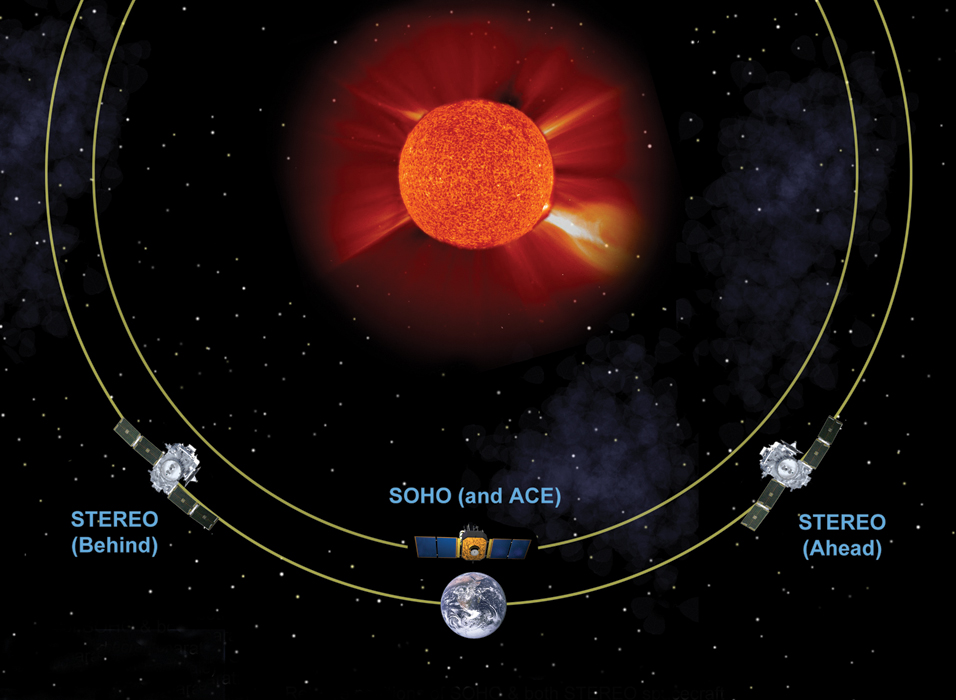STEREO, Two Years On
UNH’S LEAD SCIENTIST FOR THE STEREO mission, research associate professor Toni Galvin, reports that despite the Sun’s relatively quiet conditions the STEREO mission has already accomplished a number of “firsts.” These include the first true three-dimensional imaging of solar features, such as the twisting in solar jets. The observed spiral structure confirms theoretical models regarding the role of twisted magnetic field lines in small-scale ejection of plasma from the Sun, which may be a significant contributor to the solar wind as measured by PLASTIC.
STEREO has also provided the first detailed images showing the flow of matter from the surface of the Sun all the way to one astronomical unit (the radius of the orbit of the Earth around the Sun, or about 90 million miles). This included the first imaging of the collision between an interplanetary coronal mass ejection and a comet, in which the tail of the comet was ripped off and reformed – an occurrence termed a “disconnection event.”
For these and other achievements, the STEREO mission was ranked number one in last year’s NASA Senior Review of Heliophysics Operating Missions. The senior review is the space agency’s periodic, detailed evaluation of how well current satellite missions are meeting their science objectives.
Galvin notes that STEREO is also playing a key role in space weather predictions being made by the National Oceanic and Atmospheric Administration Space Weather Prediction Center.The NOAA center provides real-time data from STEREO, including solar wind measurements by the PLASTIC experiment.
These data are obtained through an international collaboration of ground tracking stations, including those located in France, the United Kingdom, and Japan. Key elements for predicting magnetic storms at the Earth are the observation of coronal mass ejections, and the tracking of their passage through interplanetary space. With STEREO now proceeding past the point where the twin spacecraft are 90 degrees apart – 45 degrees between each spacecraft and the Earth, the mission is well positioned for the current rise toward solar maximum.
Says Galvin, “Like watching a pitch from first and third base simultaneously, instead of only having a home plate point of view, we will now have a side view perspective of any coronal mass ejections launched from the Sun making their way toward Earth. This will allow us to determine if the mass ejection will indeed hit the Earth, and if so, when to expect it to hit and initiate a magnetic storm.”
STEREO has also provided the first detailed images showing the flow of matter from the surface of the Sun all the way to one astronomical unit (the radius of the orbit of the Earth around the Sun, or about 90 million miles). This included the first imaging of the collision between an interplanetary coronal mass ejection and a comet, in which the tail of the comet was ripped off and reformed – an occurrence termed a “disconnection event.”
For these and other achievements, the STEREO mission was ranked number one in last year’s NASA Senior Review of Heliophysics Operating Missions. The senior review is the space agency’s periodic, detailed evaluation of how well current satellite missions are meeting their science objectives.
The SOHO and ACE spacedraft, which orbit about 1 million miles closer to the Sun, provide a head-on view of what's headed toward Earth while STEREO A and B allow a side view perspective. Image courtesy of NASA |
These data are obtained through an international collaboration of ground tracking stations, including those located in France, the United Kingdom, and Japan. Key elements for predicting magnetic storms at the Earth are the observation of coronal mass ejections, and the tracking of their passage through interplanetary space. With STEREO now proceeding past the point where the twin spacecraft are 90 degrees apart – 45 degrees between each spacecraft and the Earth, the mission is well positioned for the current rise toward solar maximum.
Says Galvin, “Like watching a pitch from first and third base simultaneously, instead of only having a home plate point of view, we will now have a side view perspective of any coronal mass ejections launched from the Sun making their way toward Earth. This will allow us to determine if the mass ejection will indeed hit the Earth, and if so, when to expect it to hit and initiate a magnetic storm.”
by David Sims, Science Writer, Institute for the Study of Earth, Oceans, and Space. Published in Winter 2009 issue of EOS .

